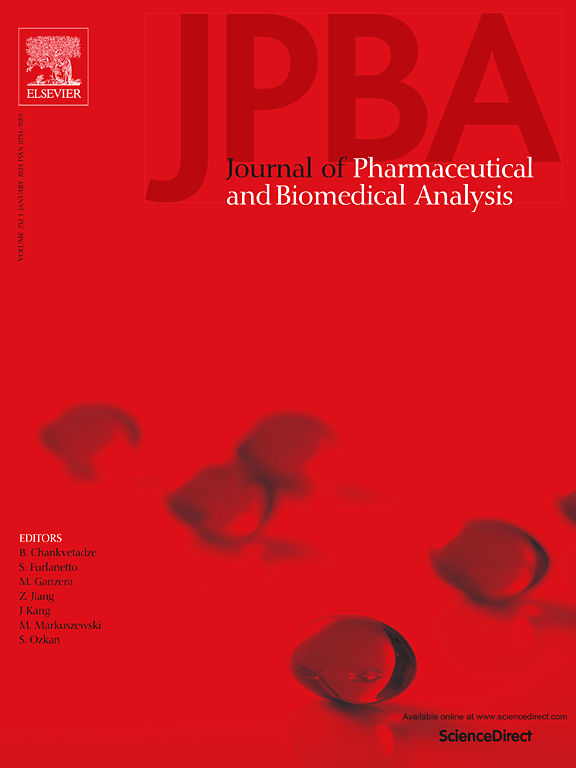Screening and verification of target and molecular docking study of Pien-Tze-Huang in ameliorating alcoholic liver injury in rats
IF 3.1
3区 医学
Q2 CHEMISTRY, ANALYTICAL
Journal of pharmaceutical and biomedical analysis
Pub Date : 2024-10-10
DOI:10.1016/j.jpba.2024.116517
引用次数: 0
Abstract
Pien-Tze-Huang (PTH) is a famous traditional Chinese patent medicine with excellent liver-protection effects. However, the mechanism of hepatoprotective action has not yet been entirely elucidated. This study aimed to elucidate the protective mechanism of PTH against alcoholic liver injury in rats from key targets. An alcoholic liver disease (ALD) model in male rats was established, and the rats were treated with PTH given at a prescribed dosage. The hepatoprotective components of PTH and their exposure in the serum of PTH-treated rats were systematically identified. Quantitative proteomics was employed to find differentially expressed proteins. The key targets were screened by bioinformatic analysis and further validated by Western blotting (WB) and molecular docking. Ursodeoxycholic acid, notoginsenoside R1, gypenoside XVII, ginsenoside Rb1, and ginsenoside Re may be important active hepatoprotective components of PTH. A total of 53 differentially expressed proteins that were reversed by PTH were successfully identified in rat liver tissues. Retinol metabolism and the PPAR signaling pathway may play a key role in ameliorating alcohol-induced liver injury after PTH intervention. In particular, protein CYP2, FATCD36, FATP, ACS, and CPT-2 in these two pathways may be key targets for the therapeutic effects of PTH, with the same reversal observed by WB. Molecular docking analysis further revealed that these five proteins exhibited generally stable binding with the five main components of PTH. The hepatoprotective effects of PTH may be exerted through the modulation of key targets within pivotal pathways. This work pioneered a comprehensive screening of the active compounds in PTH and elucidated the mechanisms and targets of their protective effects against alcoholic liver injury, providing a reference for the broader clinical application of PTH.
片仔癀改善大鼠酒精性肝损伤的靶点筛选与验证及分子对接研究
片仔癀(PTH)是一种著名的传统中成药,具有很好的保肝作用。然而,其保肝作用的机制尚未完全阐明。本研究旨在从关键靶点阐明 PTH 对大鼠酒精性肝损伤的保护机制。研究建立了雄性大鼠酒精性肝病(ALD)模型,并按规定剂量给予大鼠 PTH 治疗。系统鉴定了 PTH 的保肝成分及其在 PTH 治疗大鼠血清中的暴露量。定量蛋白质组学用于发现差异表达的蛋白质。通过生物信息学分析筛选出关键靶点,并进一步通过 Western 印迹(WB)和分子对接进行验证。熊去氧胆酸、人参皂苷 R1、人参皂苷 XVII、人参皂苷 Rb1 和人参皂苷 Re 可能是 PTH 的重要保肝活性成分。在大鼠肝组织中成功鉴定了53种被PTH逆转的差异表达蛋白。PTH干预后,视黄醇代谢和PPAR信号通路可能在改善酒精诱导的肝损伤中发挥关键作用。尤其是这两条途径中的蛋白CYP2、FATCD36、FATP、ACS和CPT-2可能是PTH治疗作用的关键靶点,WB也观察到了同样的逆转作用。分子对接分析进一步显示,这五种蛋白质与 PTH 的五种主要成分结合表现出基本稳定。PTH 的保肝作用可能是通过调节关键通路中的关键靶点实现的。这项研究开创性地全面筛选了PTH中的活性化合物,阐明了其对酒精性肝损伤的保护作用机制和靶点,为PTH更广泛的临床应用提供了参考。
本文章由计算机程序翻译,如有差异,请以英文原文为准。
求助全文
约1分钟内获得全文
求助全文
来源期刊
CiteScore
6.70
自引率
5.90%
发文量
588
审稿时长
37 days
期刊介绍:
This journal is an international medium directed towards the needs of academic, clinical, government and industrial analysis by publishing original research reports and critical reviews on pharmaceutical and biomedical analysis. It covers the interdisciplinary aspects of analysis in the pharmaceutical, biomedical and clinical sciences, including developments in analytical methodology, instrumentation, computation and interpretation. Submissions on novel applications focusing on drug purity and stability studies, pharmacokinetics, therapeutic monitoring, metabolic profiling; drug-related aspects of analytical biochemistry and forensic toxicology; quality assurance in the pharmaceutical industry are also welcome.
Studies from areas of well established and poorly selective methods, such as UV-VIS spectrophotometry (including derivative and multi-wavelength measurements), basic electroanalytical (potentiometric, polarographic and voltammetric) methods, fluorimetry, flow-injection analysis, etc. are accepted for publication in exceptional cases only, if a unique and substantial advantage over presently known systems is demonstrated. The same applies to the assay of simple drug formulations by any kind of methods and the determination of drugs in biological samples based merely on spiked samples. Drug purity/stability studies should contain information on the structure elucidation of the impurities/degradants.

 求助内容:
求助内容: 应助结果提醒方式:
应助结果提醒方式:


